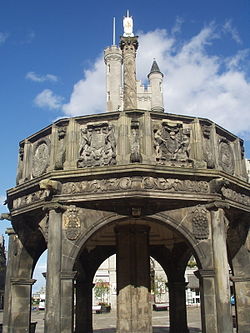
New Aberdeen is a neighbourhood in Aberdeen, Scotland.
A Royal Burgh was established by the reign of David I in the middle of the twelfth century with Alexander II establishing a Guild of Merchants in New Aberdeen in 1222. [1] It was a fishing and trading settlement where the river Denburn entered the Dee estuary. [2] The burgh of New Aberdeen was merged with Old Aberdeen in 1891 to form the county of the city of Aberdeen. [2]
The area has some of the oldest streets in Aberdeen dating from the Thirteenth and Fourteenth Centuries in New Aberdeen's historic marketplace the Castlegate where Aberdeen's Mercat cross is situated. [2]

Marischal College was founded in 1593 on the site of a disused medieval Franciscan friary by George Keith, 5th Earl Marischal of Scotland as a more Protestant alternative to Old Aberdeen's King's College. It was Scotland's second post-medieval "civic university", after the University of Edinburgh, created without a Papal bull and with a greater resemblance to the Protestant arts colleges of continental Europe [3] to train post-Reformation Kirk clergy. [4] and became known as Aberdeen's "Town College".